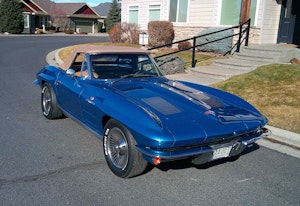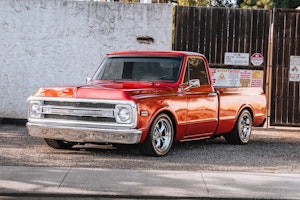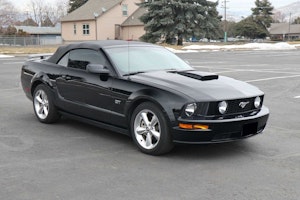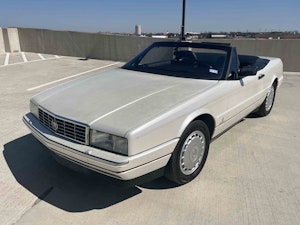Media | Articles
Should the CT5 have been a Chevelle?
Editor’s Note: “Johnny Marco” is the pseudonym of an investment-banking professional with previous career experience as a product planner for a major OEM and an auto journalist meta-critic. We’ve asked him to render the occasional opinion on missed opportunities in the business. Strap in, this might be a bumpy ride—JB
Last month’s debut of the mid-engine C8 Corvette marked the fulfillment of a decades-old prophecy. For the past 40 years, predictions of a mid-engine ‘Vette were manifold, but it wasn’t until just before the Great Recession that GM started to take action on delivering a proper evolution of America’s fiberglass sports car. Had Wall Street not socialized the losses of their experiment in securitization, the mid-engined Corvette would have been launched alongside a slate of performance-oriented, rear-drive sedans sold as the Chevrolet Impala, Buick Park Avenue, and Pontiac G6, as part of GM’s pre-bankruptcy product plans. Instead, we got a blunt-nosed C7 and a bailout.
We’re lucky that we even got a mid-engined Corvette at all, even a decade late and a generation behind where it was supposed to be. In that 10-year span, the automotive landscape has undergone the sort of shift that would normally take a lifetime. A thoroughly overhauled Corporate Average Fuel Economy regime, increasingly stringent safety standards, and the need to compete in a globalized marketplace have combined to create an irrevocable homogenization of vehicle offerings. On the demand side, consumer embrace of CUVs has led to a once unthinkable prospect—major automakers abandoning passenger cars in droves, allocating their limited resources between crossovers, pickup trucks, and the electrified, autonomous future that is perpetually on the horizon but never quite here.
The latest Cadillac CT4 and CT5 sedans—in particular, their V-Series variants, known as the CT4-V and CT5-V—are a letdown to many enthusiasts precisely because they have been forced to align with these objectives. Performance sedans with profligate V-8s and unbridled aggression were always living on borrowed time in the post-2008 marketplace, but now the bill has come due. The new Vs, with their turbocharged four- and six-cylinder engines, are more like the short-lived V-Sport trim that Cadillac experimented with—a modest bump in performance that still attempted to trade on the surprisingly durable V badge.
Marketplace
Buy and sell classics with confidence
20190415201136)
In our current vernacular, this strategy would be described as “allowing more consumers to access the V-Series brand in markets beyond the United States.” Basically, Cadillac needs to sell these cars in greater volumes, so sales outside of North America are mandatory. They needed a V-Series product to earn greater margins and give consumers in Europe and Asia a reason to buy a Cadillac rather than a European brand. The one sticking point is that the current V-6 and V-8 engines would be taxed to death in those markets due to their displacement and CO2 output levels. Notice how the engine choices in both new cars conveniently skirt the Chinese displacement tax levied on engines over 2999 cc, just like Audi’s RS5? Or how the CT4 retains the ATS’ relatively tiny footprint rather than growing in size like most new cars? These are concessions made for the Rest of the World, rather than improvements to once again be the Standard of the World.
If these cars aren’t convincing Cadillacs, could they be repurposed? Recall that Bob Lutz once mentioned that had 2008 gone differently, the Cadillac ATS would have been the next Pontiac G6, serving as a baby brother to the Pontiac G8 and its proposed still-born Zeta platform-mates. Pontiac doesn’t exist anymore, but GM still has a brand that has seen passenger car sales collapse and is in desperate need of an infusion of exciting product. That brand is Chevrolet.
Consider the strategy that FCA undertook to revive the Charger and 300 nameplates using the LX platform a decade ago—a novel, (somewhat) more driver-focused counter-argument to the commodity transverse-engined midsizer, using a borrowed platform and a pinch of nostalgia, with the economies of scale to be priced squarely in the sweet spot of an Accord EX or Camry XLE. The CT4 and CT5 could do something similar for Chevrolet. Since this is 2019, there would be the GM family turbo four- and six-cylinder engines rather than a big V-8—but there would still be a little bit of rear-drive sex appeal and a sense that the owner was driving something deliberately intended to diverge from the mainstream.
There’s some room for this idea, and some competitive incentive as well. GM has no plans to extend the Camaro’s life beyond the current generation, leaving Chevrolet without a performance offering below the C8 Corvette. FCA has been emphatic that the Charger and Challenger will continue into the next generation, and will likely get smaller. And while Ford has committed to trimming their passenger car offerings, including the Fusion/Mondeo, rumors of a four-door Mustang continue to persist.

An Alpha-based Chevrolet product (or two), essentially a rebadged version of the CT4 and CT5, would give GM a way to compete with both of these products. GM also has other avenues for Alpha that could help justify the upfront costs. Buick’s all-new Regal hasn’t really moved the sales needle, and with the sale of Opel to PSA, GM will no longer have the option of re-badging the Insignia for use as a Regal. The Regal/Insignia is also sold as the Holden Commodore in Australia, but the switch to a front-drive, Opel-based vehicle has been disastrous, with the current model posting the worst sales results since its introduction in 1948. A CT5 Commodore? Why not?
Consider that sales of the Cruze and Impala sedans are so poor that Chevrolet is killing them off in the near future. Malibu sales have seen a compounded 12 percent decline since 2010, falling from a peak of 230,000 units in 2012 to just 144,000 last year, and we can assume that a substantial portion of these are zero-margin fleet sales to rental companies and government agencies. While the sedan segment is in a secular decline thanks to the proliferation of CUVs, GM doesn’t have to cede the entire space to their rivals. They just need to offer a different proposition than the CamCordNotIma formula, something that their crosstown (and cross-Atlantic) rivals at FCA have successfully done for more than a decade.
Would a pair of rear-drive sedans with retro monikers and a modern wrapper move the needle at all like it did for FCA? All product decisions are educated guesses at best. But the conditions are right to try something novel, further recouping the high costs of a low volume, rear-drive platform like Alpha, while giving Chevrolet a pair of sedans that provide a compelling alternative. It’s not a particularly controversial decision. The Kia Stinger may not be the best-selling sedan, but the marketing buzz around the brand has provided another type of return, one that rational, well-priced products can’t ever attain regardless of how good they are. If Kia can do it, surely the General can make it happen. Oh… and those retro nameplates I mentioned? Nova and Chevelle would do quite nicely, wouldn’t they?
20190415201031)









